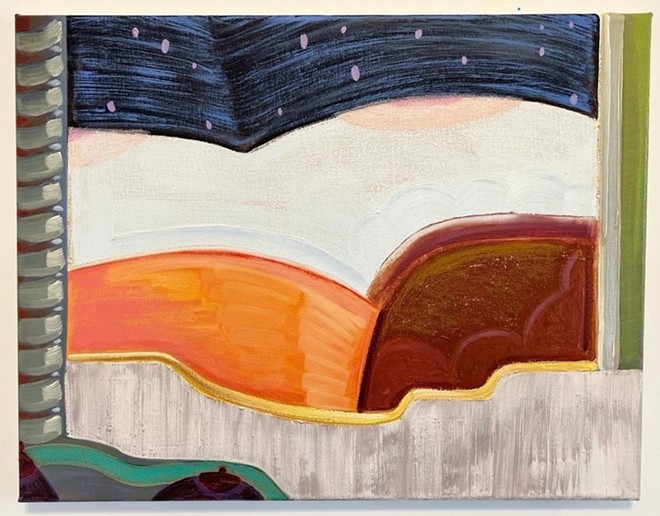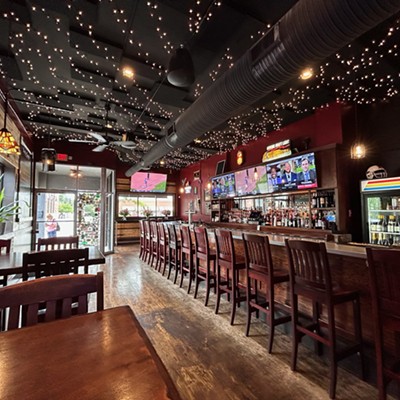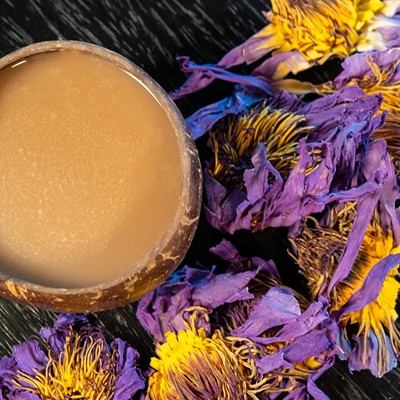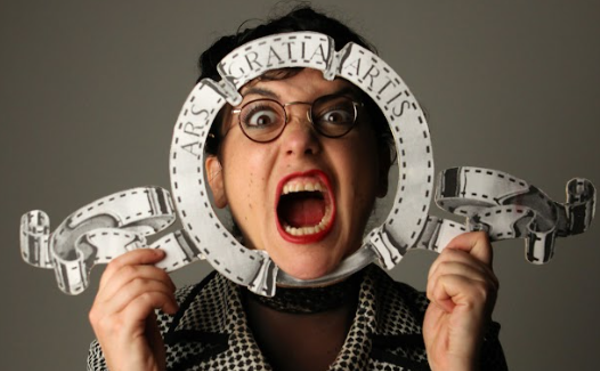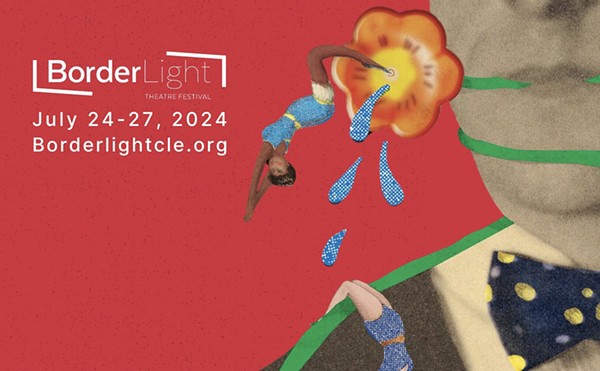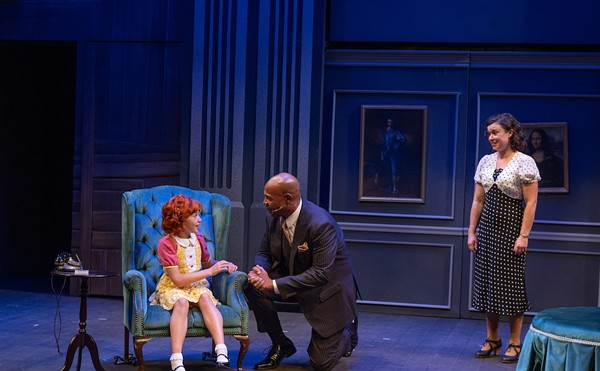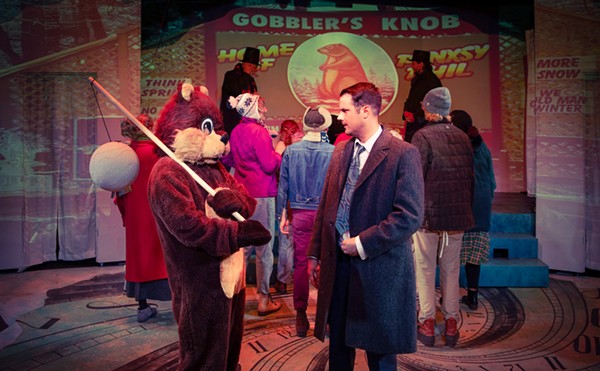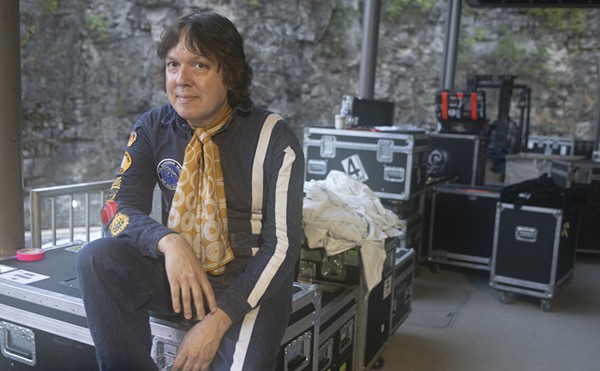“Headspace—A Painting Show” Opens Saturday at Abattoir Gallery
The works feature artists using the canvas as a place for inquiry and personal reflection
By Shawn Mishak on Wed, Mar 1, 2023 at 1:10 pm
[
{
"name": "Ad - NativeInline - Injected",
"component": "38482495",
"insertPoint": "3",
"requiredCountToDisplay": "5"
},{
"name": "Real 1 Player (r2) - Inline",
"component": "38482494",
"insertPoint": "2/3",
"requiredCountToDisplay": "9"
}
]
Headspace can mean the space between the top of an almost filled jar or container and where it seals or, more commonly, to one’s mental state. Either way, it is an engaging meditation topic for an exhibition.
Abattoir Gallery this Saturday debuts just that with "Headspace — A Painting Show," which runs through April 15.
This six-person exhibition focuses on painters “addressing the canvas as a site for inquiry and personal reflection rather than a platform for societal change or political commentary” according to a press release.
“For me, the title is suggestive of the interior processes of artists, of painters who come from a place of thought and inquiry rather than emotional reaction or expression,” said one of the artists, Scott Olson. “It is asking crucial questions about the relevance and power of painting and abstraction today. Rather than evoking a kind of hermeticism, “Headspace” asks us to look closely at the artists' intention, their thought and physical processes and the way these are presented to the world.”
These artists — three working in Ohio, one in central Pennsylvania, one in upstate New York, one in northern Connecticut — all use the medium of painting as a form of self-exploration, mining for internal as well as external inspiration in hopes to pull this onto the canvas.
“This is unique for a gallery presentation in Cleveland,” continued Olson. “Abattoir has brought these artists together around some important questions about how we view painting and abstraction today. The show is very intentional and, I think, meant to challenge the audience here to think beyond regionalism and the compartmentalization it can bring about. “
Eleanor Conover uses painting as a metaphor for environmental time and space with her non-traditional framing where the stretcher is not contained within the usual square frame but rather an oblong, cubist-like shape, sometimes exposing some of the frame and sometimes looking like a crudely shaped shield forged in the heat of battel. Her work offers Matisse-like brush strokes, and the content can be like looking through a foggy window and although sometimes the figures are present, they oftentimes loosely rendered.
Currently residing in upstate New York, Georgia Elrod abstracts the human anatomy, her compositions segmenting x-ray depictions of neck bones, ventricle arteries and rib cages, which almost read as abstract landscapes. The organic forms are rendered, at times, with pastels and have an imaginative child-like quality giving the viewer a sense of serenity while at the same time being somewhat carnal and obscure.
“My paintings contain inquiries; I aim for them to ask more questions than they answer,” said Elrod. “I think of my works as a space for subtlety, colors, sensuality and subversion. I do believe that making paintings, and the dialogue that ensues from engaging with art, can lead to societal changes.”
Based in Norfolk, CT, Fox Hysen’s work is mostly abstractions in the vein of Rothko who said, “I'm not an abstractionist. I'm not interested in the relationship of color or form or anything else. I'm interested only in expressing basic human emotions: tragedy, ecstasy, doom, and so on.”
Hysen’s passion is conveyed in her work, which is vividly expressive using color, shapes and sometimes mixed media to balance a composition. It can be wildly erratic while pensively atonal. Cubist elements come to the forefront of some of the pieces harkening back to this period in art.
Hysen meditates on the transformative power of art: “An art object has the ability to transform an environment, to condition the space phenomenologically and affectively – in other words art can change the mood of space, it can bring up different thoughts and feelings.”
A professor of art at the University of Akron, Matthew Kolodziej references architecture and filters his work through computer programs, projects them onto the canvas and traces using gel mediums the result of which is a tapestry of history archeology and topography. There are sometimes Pollok-esque qualities elicited by these unusual, fascinating and seemingly endless labyrinths of lines and textures.
“Combining walking and collection is a means of using chance encounters with artifacts to define and disrupt compositional choices,” saidKolodziej.
Scott Olson, based In Kent, builds his frames from wood sourced from Northeast Ohio trees which gives them a physical connection to his history and to his surroundings. While some of his works have cubist shapes, much of it while abstract, has a fluidity and unity propelling it. The colors are expertly chosen, the compositions vibrate with energy and the brush strokes and pastel colors at times remind me of Georgia O'Keeffe’s smooth blending of pigment.
“As a student of art history, we can look back and study the provocative power of art and abstraction- as a promulgation of political ideology, revolution and subversion,” said Olson. “However, gone are the days that an opera or painting will cause a riot as they did in the past. The medium has changed, the systems of information have changed. The technology we utilize to navigate and experience the world has changed- and changed us.”
Cincinnati-based Emil Robinson’s work incorporates the simplicity and beauty in still lifes with other more ethereal elements, capturing a mood using a light source as a calibrator, manipulating and juxtaposing objects in a composition to where they lose their earthy utility and somehow are invigorated with a new interpretation of existence. The work can leave the viewer simultaneously bewildered while also enthralled. The pieces sometimes tell a story without any clear narrative. The realism is impressive and her voice as an artist is unique and one where we don’t necessarily need all the details in order to appreciate its emotional resonance.
“My paintings are carefully planned, but also based on a sort of hunch- a momentary recognition of something which opens a psychological door,” said Robinson.
Editor's note: A previous version of this story referred incorrectly to Fox Hysen. She is female. We regret the error.
Coming soon: Cleveland Scene Daily newsletter. We’ll send you a handful of interesting Cleveland stories every morning. Subscribe now to not miss a thing.
Follow us: Google News | NewsBreak | Instagram | Facebook | Twitter
SCENE Supporters make it possible to tell the Cleveland stories you won’t find elsewhere.
Become a supporter today.
Scroll to read more Arts Stories & Interviews articles
Newsletters
Join Cleveland Scene Newsletters
Subscribe now to get the latest news delivered right to your inbox.

